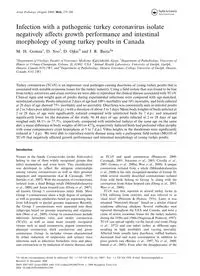
2009 Infection with a pathogenic turkey coronavirus isolate negatively affects growth performance and intestinal morphol PDF
Preview 2009 Infection with a pathogenic turkey coronavirus isolate negatively affects growth performance and intestinal morphol
Infection with a pathogenic turkey coronavirus isolate negatively affects growth performance and intestinal morphology of young turkey poults in Canada M. H. Gomaa1, D. Yoo2, D. Ojkic3 and J. R. Barta4* 1Department of Virology, Faculty of Veterinary Medicine, Kafrelsheikh, Egypt, 2Department of Pathobiology, University of Illinois at Urbana-Champaign, Urbana, IL 61802, USA, 3Animal Health Laboratory, University of Guelph, Guelph, Ontario, Canada N1G 2W1, and 4Department of Pathobiology, Ontario Veterinary College, University of Guelph, Ontario, Canada N1G 2W1 Turkey coronavirus (TCoV) is an important viral pathogen causing diarrhoea of young turkey poults that is associated with sizeable economic losses for the turkey industry. Using a field isolate that was found to be free from turkey astrovirus and avian reovirus we were able to reproduce the clinical disease associated with TCoV. Clinical signs and weight gain of poults during experimental infections were compared with age-matched, uninfected controls. Poults infected at 2 days of age had 100% morbidity and 10% mortality, and birds infected at 28 days of age showed 75% morbidity and no mortality. Diarrhoea was consistently seen in infected poults at 2 to 3 days post infection (d.p.i.) with a duration of about 3 to 5 days. Mean body weights of birds infected at 2 or 28 days of age were significantly reduced compared with uninfected birds by 7 d.p.i. and remained significantly lower for the duration of the study. At 44 days of age, poults infected at 2 or 28 days of age weighed only 68.1% or 77.7%, respectively, compared with uninfected turkeys of the same age on the same diet, a mean difference in body weights of 683 or 477g, respectively. Infected birds had profound villus atrophy with some compensatory crypt hyperplasia at 5 to 7 d.p.i. Villus heights in the duodenum were significantly reduced at 7 d.p.i. We were able to reproduce enteric disease using only a pathogenic field isolate (MG10) of TCoV that negatively affected growth performance and intestinal morphology of young turkey poults. Introduction Viruses in the family Coronaviridae (order Nidovirales) belong to one of three widely recognized groups that infect mammalian and avian hosts. This classification was developed to reflect the antigenic relationships among various coronaviruses as well as their genomic sequences and organizations (Lai & Cavanagh, 1997; Sawicki et al., 2007). With the exception of coronaviruses isolated from a dead Beluga whale (Mihindukulasuriya et al., 2008) and Asian leopard cats (Dong et al., 2007), all known Group 3 coronaviruses infect birds. Most Group 3 coronaviruses share a high degree of antigenic as well as genomic similarities based on sequencing data from full-length or partial genome sequences. Recently, the Group 3 coronaviruses were separated into three subgroups based on genome sequencing and organiza- tion (Woo et al., 2009). Group 3a coronaviruses include infectious bronchitis virus and turkey coronavirus (TCoV), as well as some more recently recognized viruses such as quail coronavirus, pigeon coronavirus, pheasant coronavirus, duck coronavirus and goose coronavirus. Group 3a includes viruses characterized by either induction of respiratory and urinary tract infections such as infectious bronchitis virus and phea- sant coronavirus or by induction of enteric diseases such as TCoV and quail coronavirus (Pennycott, 2000; Cavanagh, 2001; Jonassen et al., 2005; Circella et al., 2007; Gomaa et al., 2008a; Woo et al., 2009). A unique coronavirus isolated from a whale (Mihindukulasuriya et al., 2008) is the only recognized member of Group 3b, while several recently described coronaviruses isolated from wild birds belong to Group 3c along with the coronavirus from Asian leopard cats (Dong et al., 2007; Woo et al., 2009). TCoV was first reported in several turkey farms in USA suffering from enteritis, and was referred to as ‘mud fever’ (Peterson & Hymas, 1951). Later, it was renamed ‘‘bluecomb disease’’ based on a similar clinical syndrome affecting chickens. Several outbreaks were reported throughout the USA and Canada, and were a cause of severe economic losses for the turkey industry during the 1950s and 1960s (Nagaraja & Pomeroy, 1997). TCoV can spread rapidly via the faecal�oral route (Naqi et al., 1972) and can infect turkey at different ages, resulting in high morbidity and varying mortality. Affected birds usually have diarrhoea, ruffled feathers, decreased feed and water consumption in addition to poor growth rate (Barnes et al., 1997; Yu et al., 2000; Ismail et al., 2003). Even after the disappearance of the *To whom correspondence should be addressed. Tel: �1 519 824 4120, ext. 54017. Fax: �1 519 824 5930. E-mail:
